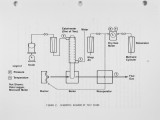| Title |
Burner System Development for a Gas-Fired Absorption Heat Pump |
| Creator |
Barnhart, J. S.; Appelbaum, H. R.; Maret, A. R. |
| Publisher |
University of Utah |
| Date |
1985 |
| Spatial Coverage |
presented at Livermore, California |
| Abstract |
This paper describes the design and testing of a burner system for a natural-gas-fired absorption heat pump. The absorption heat pump, under development for the Gas Research Institute, is a modular device intended to provide both heating and cooling for residential and small commercial applications. The subject burner system remains under active development at the time of writing. Accordingly, this paper summarizes the development process from conceptualization through experimental evaluation of a second generation prototype. Design criteria and the processes by which major components were selected are described. The criterion of primary interest to date, a steady-state thermal efficiency goal of 85 percent, has been achieved in tests documented herein. Th.s paper includes efficiency data as well as stack and jacket losses for first- and second-generation prototypes. Future tests to determine transient behavior and suitability for outdoor operation are also described. |
| Type |
Text |
| Format |
application/pdf |
| Language |
eng |
| Rights |
This material may be protected by copyright. Permission required for use in any form. For further information please contact the American Flame Research Committee. |
| Conversion Specifications |
Original scanned with Canon EOS-1Ds Mark II, 16.7 megapixel digital camera and saved as 400 ppi uncompressed TIFF, 16 bit depth. |
| Scanning Technician |
Cliodhna Davis |
| ARK |
ark:/87278/s6k64mmw |
| Setname |
uu_afrc |
| ID |
2247 |
| Reference URL |
https://collections.lib.utah.edu/ark:/87278/s6k64mmw |
















